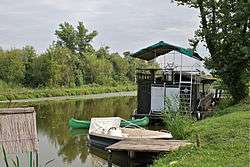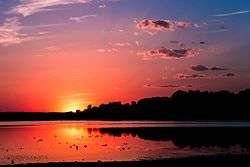Carska Bara
| Imperial Pond | |
|---|---|
 Carska Bara | |
| Location | Zrenjanin, Serbia |
| Coordinates | 45°15′47″N 20°23′56″E / 45.263°N 20.399°ECoordinates: 45°15′47″N 20°23′56″E / 45.263°N 20.399°E |
| Basin countries | Serbia |
| Max. length | 9 km (5.6 mi) |
| Surface area | 4.726 ha (11.68 acres) |
Carska Bara (Serbian Cyrillic: Царска бара), meaning Imperial Pond,[1] is the largest individual bog in Serbia, located in the municipality of Zrenjanin. It is part of the major nature reserve, officially Special Nature Reserve "Carska Bara" (Специјални резерват природе "Царска бара").
Location
Carska Bara is located 17 kilometers south of the town of Zrenjanin, in the west-central part of the Serbian section of Banat, near the mouth of the river Begej into the Tisa. The southern border is bounded by the final, navigable section of the Begej before it empties into the Tisa (followed by the Belgrade-Zrenjanin road), while to the north are the vast Ečka fishponds, the largest in Serbia. Entire bog belongs to the municipality of Zrenjanin.
Settlements and human history

Even though it is located in the triangle of large cities Belgrade-Novi Sad-Zrenjanin (largest cities in Serbia, Vojvodina and Serbian Banat, respectively), all settlements in the vicinity of Carska bara are smaller ones, ranging from 1,500 to 6,000 inhabitants. The closest settlements are Perlez, in southern corner, on the Begej, and Belo Blato, east of the bog, on the southern shore of Ečka fishpond. In the north are the villages of Lukino Selo, Ečka and Stajićevo, while Knićanin is southwest of it. Town of Titel is right across the bridge on the Tisa. Gallery of the painting colony of "Ečka" is located on the northern tip of the bog.
Human history in the area surrounding Carska bara goes back to 4,000 years BC, with uncovered mounds near Mužlja (Batka) and Titel (Kalvarija). According to legend, the bog (carska bara, Serbian for "imperial bog"), was named after Attila, king of the Huns.[2]
Geography
The entire, physically connected wetland of Carska Bara covers an area of 11 square kilometers and the entire system consists of three smaller, connected ponds (Carska, Perleska and Tiganjica).[3] It extends for 8 to 9 kilometers along the Begej (approximately from Begej's 4th to 15th kilometer).[4] Wetland consists of many smaller bodies of water: rivers, canals, lakes and ponds, covered with reed beds, willow thickets and rushes and it is known for its color diversity. The central, lake section is known for its blue, clear water, while the surrounding salt marshes have white and yellow waters, all within green woods. Previously, Carska Bara consisted of smaller and larger swamps, but in time it basically turned into a complex of Begej's meanders which are naturally getting shortened and narrowed and the bog gets more and more inclined compared to the river bed.
Biology

Flora
Many rare and autochthonous plants live in the wetland, but also many imported ones. Some representatives of the water plants include water fern, white water lilly and water farina. Meadow plants are represented by Plumbago, Achillea, wormwood, mallow and meadow sage and marsh plants by flowering rush, yellow flag iris, water mannagrass and common sweet flag, etc.
Altogether, there are some 500 plant species registered in the reserve, including rare or protected species, like yellow pheasant's eye, St John's wort, Orchis and buttercup. The colonies of old willow groves are preserved, so as the forests of the black poplar and narrow-leafed ash. There are rare specimens of pedunculate oak.[5]
Fauna
In Carska Bara and nearby Begej river there are 24 different species of fish.[5] Amphibians (fire salamander, edible frog) and reptiles (sand lizard, European pond terrapin) are also abundant. Despite being a marshland, in Carska bara there is a noticeable absence of mosquitos which local biologists attribute to the large number of frogs.[5]
Carska Bara is the best known for its abundant bird life, as 240 bird species live in it.[6] There are colonies of herons and cormorants (including pygmy cormorant), and other species include buzzards, Eurasian sparrowhawks, common spoonbills, western marsh harrier, Montagu's harrier, red-breasted goose, osprey, wild goose, stork, woodcock etc.
Some 50,000 greater white-fronted geese spend December-January each year in Carska Bara on their voyage from Siberia to the South Europe. Other birds include swans, white-tailed eagles, ferruginous ducks, 8 species of herons, gulls and pelicans, while the cormorant colonies have 3,000 members. It is suggested that such a large number of birds actually prevents the bog from freezing during the winter.[5]
Variety of mammals include otters, European ground squirrel, wildcats, bank vole[5] and also wild hog, roe deer, red fox, European brown hare, muskrat, bats, hedgehog, mole, weasel, hamster, European polecat, etc.
Nature Reserve
Special Nature Reserve "Carska Bara" was proclaimed in 1955, with status being revised in 1995. It covers an area of 16.76 square kilometers, wider than Carska Bara itself.[7] It was declared a Ramsar site on March 25, 1996.[8] Fish farm „Еčka“ was appointed by Decree of the government of Republic of Serbia to act as an administrator and manager of Special Nature Reserve „Carska bara“ („Official Gazette RS” No 56/94, 86/05 and 46/2011)
References
- ↑ Zrenjanin.rs, Touring the environs Archived March 4, 2016, at the Wayback Machine.
- ↑ Carska Bara (Serbian only) Archived January 18, 2008, at the Wayback Machine.
- ↑ Jovan Đ. Marković (1990): Enciklopedijski geografski leksikon Jugoslavije; Svjetlost-Sarajevo; ISBN 86-01-02651-6
- ↑ Turističko područje Beograda, "Geokarta", 2007, ISBN 86-459-0099-8
- 1 2 3 4 5 N.Kovačević (8 December 2008), "Sibirske guske u Carskoj bari", Politika (in Serbian), p. 07
- ↑ Blic daily, Staništa retkih ptica, April 25, 2007
- ↑ "Serbia heading for sustainable tourism". Serbia: Approaching the summit on sustainable development. Johannesburg: Ministry of Environmental Protection of Republic of Serbia. 2002-04-26. p. 24.
- ↑ Ramsar.org, List of Ramsar sites Archived July 12, 2007, at the Wayback Machine.
External links
| Wikimedia Commons has media related to Carska bara. |